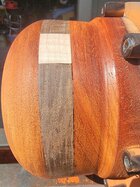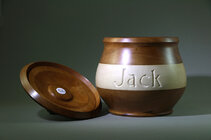-
December 2025 Turning Challenge: Single Tree! (click here for details) -
Congratulations to Bob Henrickson, People's Choice in the November 2025 Turning Challenge (click here for details) -
Congratulations to Guillaume Fontaine for "Old Tea Pot" being selected as Turning of the Week for December 15, 2025 (click here for details) -
Welcome new registering member. Your username must be your real First and Last name (for example: John Doe). "Screen names" and "handles" are not allowed and your registration will be deleted if you don't use your real name. Also, do not use all caps nor all lower case.
You are using an out of date browser. It may not display this or other websites correctly.
You should upgrade or use an alternative browser.
You should upgrade or use an alternative browser.
GAP FILLING OPTIONS
- Thread starter Chris Roades
- Start date
If possible, I like to fill gaps with sawdust from the adjacent wood. On small checks and cracks John Lucas taught me a trick: wet sand with thin CA glue on coarse sandpaper. But that’s a pretty big gap. Do you know if it gets larger or smaller as more wood is removed?
I wonder if it’s still concentric while in the cole jaws if it might be possible to a thin, even gap all the way around, then fill it with something dark or glue in thin strips of veneer.
BTW, gluing up layers can be tricky. I like to run the layers through the drum sander to get both surfaces parallel. There’s a better method that doesn’t use a drum sander but involves turning and truing rings one at a time but it’s more involved. If I can find the document I use for teaching multi-layer boxes, I’ll try to post it. (Unfortunately, I may not be able to get to those files for a few days.)
Oh, I just found a file with five pages of “unpolished” drawings describing the multi-ring method. I’ve used this method to make a number of multi-layer “Beads of Courage” boxes. It works extremely well and always had tight joints. From what I can see of your design, the middle layer would need to be glued up separately. A drum sander, or better, a jointer would be great for this if you have access to them.
JKJ
I wonder if it’s still concentric while in the cole jaws if it might be possible to a thin, even gap all the way around, then fill it with something dark or glue in thin strips of veneer.
BTW, gluing up layers can be tricky. I like to run the layers through the drum sander to get both surfaces parallel. There’s a better method that doesn’t use a drum sander but involves turning and truing rings one at a time but it’s more involved. If I can find the document I use for teaching multi-layer boxes, I’ll try to post it. (Unfortunately, I may not be able to get to those files for a few days.)
Oh, I just found a file with five pages of “unpolished” drawings describing the multi-ring method. I’ve used this method to make a number of multi-layer “Beads of Courage” boxes. It works extremely well and always had tight joints. From what I can see of your design, the middle layer would need to be glued up separately. A drum sander, or better, a jointer would be great for this if you have access to them.
JKJ
Attachments
I use black CA glue, it contrast with the other colors and blends in. You could create a similar gap on the closed side using a point tool or such, so it balances .
Thank you very much. Yes, the issue with my situation is that I'm working with limited space and limited tools so nice 90 degree angles and true edges are not always easy to come by. Let me review that document and see what I can do. Thank you again.
Chris
Chris
With gaps that big, I rip tapered pieces of wood on the table saw. Something like 3/32 thick to sharp edge and glue that in. I've NEVER like glue and sawdust except for the tiniest of gaps. Get over 1/63" and you will likely see cracking again when the wood moves.
Crap in the gap. No way to hide it. Best to start over, work on making joints that fit. You could cut apart and reuse the padauk using a cradle on the bandsaw and reglue with a new segmented ring.
The old carpenter's plea, "Putty and paint, make me what I ain't."
The old carpenter's plea, "Putty and paint, make me what I ain't."
- Joined
- Apr 27, 2004
- Messages
- 9,306
- Likes
- 6,060
- Location
- Lakeland, Florida
- Website
- www.hockenberywoodturning.com
I’m one that tosses pieces that don’t work out.
A lot of time and effort to make a fix that I won’t like.
One thought is to fill it with anything then paint the piece with black gesso
Before painting turn 4 grooves - a groove on each side of the bad ring and a groove above and below the center ring
Choose a distance you like or one that fits your carving plan.
This Leaves the top and bottom un painted.
Then leave the band in the middle black and carve on the other two bands.
Carving can just be lines with a vee palm gouge.
Grafitto is a technique of carving through a surface.
The downside of this is the paduk will look fantastic against the black until it turns black itself
Maybe a yellow or orange milk paint for the top and bottom bands.
Just a thought
A lot of time and effort to make a fix that I won’t like.
One thought is to fill it with anything then paint the piece with black gesso
Before painting turn 4 grooves - a groove on each side of the bad ring and a groove above and below the center ring
Choose a distance you like or one that fits your carving plan.
This Leaves the top and bottom un painted.
Then leave the band in the middle black and carve on the other two bands.
Carving can just be lines with a vee palm gouge.
Grafitto is a technique of carving through a surface.
The downside of this is the paduk will look fantastic against the black until it turns black itself
Maybe a yellow or orange milk paint for the top and bottom bands.
Just a thought
With flat work hiding the flaws is the real skill. Wood glue and sawdust / sanding
I would consider using a thin parting tool and separating the piece along the faulty glue line. Then re-prepare the two mating surfaces and re-glue. Using sandpaper glued to a board is a good method for getting turned surfaces perfectly flat and square. All of this done on the lathe
- Joined
- Jul 18, 2018
- Messages
- 1,334
- Likes
- 2,877
- Location
- Baltimore, MD
- Website
- loujacobswoodturning.com
Depending on how thick your wall is, how about using a parting tool to cut a clean groove on the seam partway in and fill with epoxy putty. I’ve never used it, but I’ve seen mentions of Milliput putty that folks seem to like. Apparently available in various colors.
This.... How did you cut your segments?I would consider using a thin parting tool and separating the piece along the faulty glue line. Then re-prepare the two mating surfaces and re-glue. Using sandpaper glued to a board is a good method for getting turned surfaces perfectly flat and square. All of this done on the lathe
Roger Wiegand
Beta Tester
Saw it apart (or use a parting tool for the one on which that will work), resurface the uneven joints, and re-glue.
You could use a parting tool to cut a clean line and fill it with crushed opal.
create a shallow groove with a parting tool- fill with colored thickened epoxy then sand flush - make it a decorative ring accent


